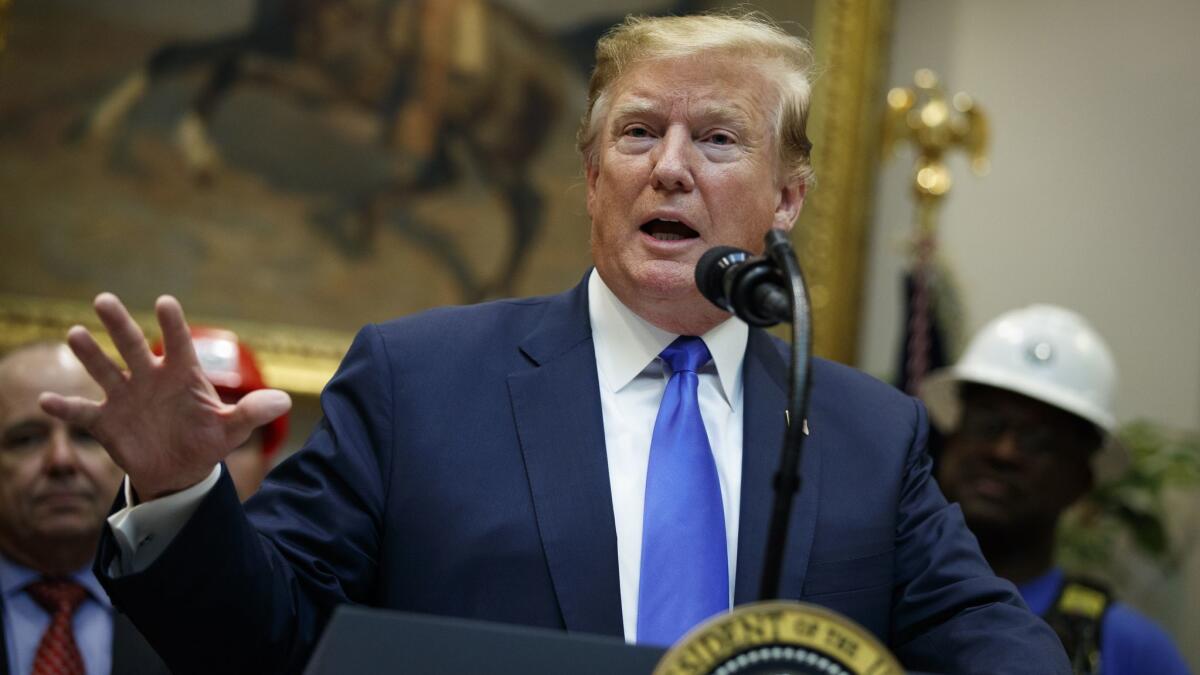Editorial: In the Trump White House, the Cabinet is remarkably bare

- Share via
Turnover at the top levels of the Trump administration has set a modern record for turmoil. As of this week, with the departure of Linda McMahon from the Small Business Administration and Secretary Kirstjen Nielsen from the department of Homeland Security, 14 of President Trump’s Cabinet members will have left their jobs.
One result of all this upheaval is that only 17 of the 22 top officials currently holding Cabinet or Cabinet-level positions have been confirmed for those jobs by the Senate. In other words, nearly a quarter of the administration’s top executive offices are filled by “acting” appointees without Senate approval.
Trump, who likes to brag that he hires “the best people” and that his White House runs like “a well-oiled machine,” seems to have no problem with this outrageous state of affairs. Earlier this year, he tipped his hand, telling reporters that “I’m in no hurry. I have ‘acting’ [appointees] and my ‘actings’ are doing really great…. I sort of like ‘acting.’ It gives me more flexibility; do you understand that? I like ‘acting.’”
Nearly a quarter of the administration’s top executive offices are filled by “acting” appointees without Senate approval.
But in fact, there are serious problems with bypassing Senate confirmation. First is the erosion of the balance of powers between the coequal branches of government. Under the Constitution, the president has the right and the responsibility to nominate people to lead his agencies and serve in other top-level jobs. But the Senate has the right and responsibility to confirm or, if the nominee is deemed inappropriate, to reject those nominees.
Yes, there are times when an acting or interim appointment is necessary, particularly after the sudden departure of a confirmed official, but Trump’s reliance on them in so many positions makes it impossible for the Senate to perform its mandated oversight role or to hold the executive branch accountable. That’s a troubling power shift in which Majority Leader Mitch McConnell (R-Ky.), for all his protestations of holding respect for the traditions of the Senate, has quietly acquiesced.
It also causes internal operational problems. Top executives in bureaucracies as large as those within the federal government have less influence and authority if their employees feel that they’re short-timers or lack a necessary imprimatur or are not fully ensconced. That can make it more difficult for them to enact policy.
Enter the Fray: First takes on the news of the minute »
Trump has added to the vacuum of leadership by failing to nominate people for nearly 140 other key top-level positions that are important to the smooth running of the vast bureaucracy. Leaving jobs leaderless is obviously bad management, and the president’s assertion that this is part of reducing big government is just silly — 140 fewer jobs, or even several thousand fewer if you include some of the lower-level management jobs he’s left vacant, won’t make much of a dent in a federal workforce of more than 2.5 million.
None of this seems to bother the president who, after all, has boasted that “I alone can fix it.” On Wednesday, he told reporters (not long after pushing out Nielsen) that “there’s only one person that’s running” the Department of Homeland Security. “You know who that is? It’s me.”
So we have a government led by an egotist who has repeatedly shown he is bored by policy now asserting personal control over the department that protects the borders, controls immigration, guards against terrorism and responds to natural disasters. What could possibly go wrong?
Follow the Opinion section on Twitter @latimesopinion or Facebook
More to Read
A cure for the common opinion
Get thought-provoking perspectives with our weekly newsletter.
You may occasionally receive promotional content from the Los Angeles Times.









